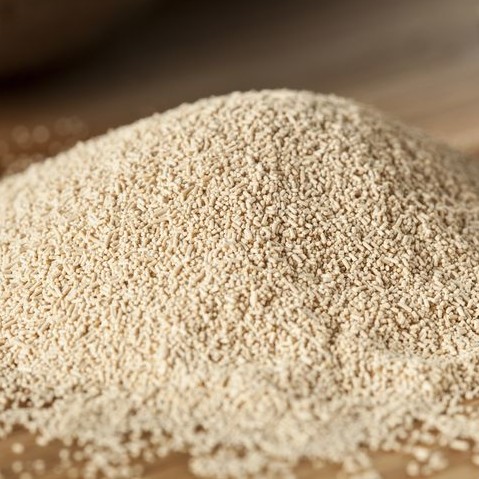Dry Yeast
Also known as active dry yeast, baker’s yeast or compressed dry yeast
What is dry yeast?
Dry yeast is the dehydrated form of Baker’s yeast that does not require refrigeration and is characterized by long shelf life. It is used in various baking formulations to enhance texture and provide desirable flavor.
Commercially available forms of dry yeast include: 1
- Instant dry yeast: added directly to the flour mix
- Active dry yeast: requires short rehydration before usage
- Free-flowing frozen dry yeast: for frozen doughs
- Dry yeast with reducing power: available in active or deactivated form
Origin
Granulated dried yeast which did not require refrigeration and had double the fermentation power of wet yeast was developed by Fleischmann’s during WWII. in 1973, Lesaffre launched instant dry yeast which showed a better market potential for commercial baking operations. The predominant yeast strain is S. cerevisiae. Other strains such as S. rosei, S. delbrukii and S. exiguus were developed for high sugar doughs, flavor enhancement and sourdough starters, respectively.1
Function
This yeast has several important functions in baked goods: 1
- Dough rising: leavens dough through the production of carbon dioxide.
- Acidification: reduces pH during the production of carbon dioxide and organic acids.
- Flavor and aroma: flavor compounds are produced during fermentation, thus contributes to the characteristic flavor and aroma of baked goods.
Nutrition
Typical dry yeast nutritional value per 100 g:2
| Component | Grams |
|---|---|
| Carbohydrate | 40 |
| Protein | 40 |
| Fat | 5 |
| Water | 15 |
This yeast is a good source of vitamins D and B as well as minerals such as potassium and zinc. These nutrients are associated with some health benefits like lowering cholesterol, and managing neurological and cardiovascular disorders.2
Commercial production
Dry yeast is commercially obtained through the following process:1
- Conditioning: molasses is conditioned for its use as food for yeast propagation.
- Multiplication: yeast cells are added to molasses and placed in a series of containers.
- Maturing: yeast is stabilized by removing nitrogen and increasing the supply of molasses and temperature above 29 – 34 oC (84.2 – 93.2 oF ).
- Separation: yeast cells are separated from wort using centrifugal equipment and the cream is recovered.
- Drying: the yeast cream is dried to appropriate moisture using a vacuum drier.
- Packaging: dried yeast pellets are packaged in 125- 500 g sachets, or 10 kg packets.
Application
Viability of dry yeast can be affected by several factors, mainly:1,3
| Factor | Effect | Observation |
|---|---|---|
| Temperature | Optimum fermentation occurs between 25 – 28 oC (778 – 82 oF) | At 50 oC (120oF) or higher, fermentation rate decreases due to yeast cells death. |
| Salt | Depending on level, it can retard or inhibit yeast fermentation | For rapid fermentation, salt level should be reduced. |
| Sugar |
At 5-10% (baker’s percentage) it increases yeast activity.
Above 10% (baker’s percentage) yeast activity decreases. |
Sucrose, glucose and fructose are rapidly fermented. While maltose ferments slowly.
For lean yeast dough, a mix of rapid and slow fermented sugar should be used |
| pH |
Optimum fermentation pH is 4-6.
Above or below this range, yeast fermentation slows. |
Yeast provides part of the acid to accomplish the appropriate pH. |
| Antimicrobial agent | May stop or slow fermentation |
Calcium propionate must be added at appropriate levels.
Cinnamon may slow yeast fermentation, thus should be sprinkled on the dough or use microencapsulated form. |
| Yeast dosage | Higher levels result in faster fermentation |
May impart an undesirable yeasty flavor.
Not suitable for long fermentations. |
| Osmotic pressure | Decreases yeast fermentation rate up to an hour or more in high sugar environments | Doubling or tripling the required yeast level in rich or sweet doughs can decrease fermentation times. |
Guidelines for substituting dry yeast with fresh yeast:1,3
- For active dry yeast: use half the amount as fresh yeast.
- For instant dry yeast: multiply the amount of fresh yeast required by 0.35.
Regulations
Three dried yeast varieties (Saccharomyces cerevisiae and Saccharomyces fragilis and Candida utilis) are permitted for direct addition to food products by the FDA.4
In the EU, the production of organic yeast is regulated by the EU Commission 1254/2008.5
References
- Hui, Y. H., ed. Handbook of food science, technology, and engineering. Volume 2. CRC press, 2006.
- U.S. Department of Agriculture, Agricultural Research Service. FoodData Central, 14 July 2017. https://fdc.nal.usda.gov/fdc-app.html#/food-details/368813/nutrients . Accessed 29 October 2020.
- Figoni, P. How Baking Works: Exploring The Fundamentals Of Baking Science. 2nd ed., John Wiley & Sons, Inc., 2008.
- U.S. Department of Health and Human Services.” Food Additives Permitted For Direct Addition To Food For Human Consumption.Title 21 Code of Federal Regulation, Part. 172. April 2019. Available at https://www.accessdata.fda.gov/scripts/cdrh/cfdocs/cfcfr/cfrsearch.cfm?fr=172.896 . Accessed 29 October 2020.
- European Commission (EC). Commission Regulation (EC) No 1254/2008 of 15 December 2008 amending Regulation (EC) No 889/2008 laying down detailed rules for implementation of Council Regulation (EC) No 834/2007 on organic production and labelling of organic products with regard to organic production, labelling and control . Official Journal of European Communities, 15 December 2008.


